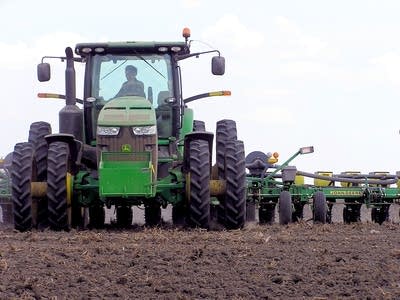Minn. farmers behind schedule, but expect good growing season
Go Deeper.
Create an account or log in to save stories.
Like this?
Thanks for liking this story! We have added it to a list of your favorite stories.

-- After a summer of drought and a winter that seemed endless, Minnesota farmers welcomed some decent planting weather over the past week.
Many made good progress sowing their fields before the rains returned, and shut down work again in most of the state. Even though planting is now running behind, farmers still believe they will see a good crop.
"Sun's out, warm weather, winds from the south, it's an ideal planting day," farmer Alan Roelofs said earlier this week.
The wet spring, complete with snowstorms, has been difficult for farmers eager to get a crop in the ground. So when the weather took a more spring like turn, it was a welcome sign that the fields were ready.
Turn Up Your Support
MPR News helps you turn down the noise and build shared understanding. Turn up your support for this public resource and keep trusted journalism accessible to all.
Roelofs, 63, farms near Tyler in southwest Minnesota with his son and son-in-law. As they prepared to seed a field, they tore bags of corn and dumped the seed into plastic hoppers on their corn planting rig.

"Looks like we're ready," Roelofs said after sliding the seed bin cover in place. "Good day to be a farmer."
Last fall, good days to be a farmer were scarce. Southwestern Minnesota was in extreme drought. But the wet spring has moderated the dry conditions.
When Roelofs starts his tractor and pulls the planter into a 60-acre field, he'll need about four hours to seed, planting 24 rows at a time at just over six miles an hour.
"The ground's dry enough, and [we] haven't had to worry about getting stuck or anything," he said. "It's been working really nice."
While Roelofs and other farmers in western Minnesota have finally been able to start planting, heavy precipitation in other parts of the state has prevented most field work.
The worst conditions seem to be in south central and southeast Minnesota, where conditions have been so wet that the drought has disappeared in just the past month. Since early April, precipitation in Rochester has been nearly six inches above normal.
"We've been saturated basically all spring," said Dan Nielsen, a crop consultant near the Iowa border in southeast Minnesota. "There's been basically two [to] three days where farmers been able to get out in our light, sandy soils. There's virtually zero planted around here."
"Just because we're getting in a little bit later, doesn't guarantee that we're going to have lower yields."
Nielsen said the region needs three consecutive dry days before the fields are ready to work. The good news is it looks like farmers may get that break. Warmer, drier weather is in the forecast for next week.
If that forecast proves accurate, farmers statewide may be able to plant a lot of corn quickly, and beat the ticking agricultural clock.
But a wet spring is not fatal to crop potential, said University of Minnesota extension crops specialist Liz Stahl.
"Just because we're getting in a little bit later, doesn't guarantee that we're going to have lower yields," she said.
For farmers, May 20 is an important date, as corn planted before then has a good chance of returning a near normal yield.
Although the planting delays are painful, Stahl said there is a beneficial side to all the precipitation: It markedly reduced the portion of the state with drought conditions.
"You can plant as early as you want, but if you don't have moisture you're going to be out of luck in the end," she said.
Eighty-five percent of the state is still abnormally dry or in drought, but Stahl said most areas have enough soil moisture to sprout seeds and furnish crops a good drink to get started.
As Roelofs pilots his corn planter across his field, he notes that no one can predict how the crop will turn out. Weather patterns can change quickly. Just last year a great early growing season in this part of the state went downhill when drought took hold in mid-summer.
But on a 70 degree, sunshiny day in early May, farmers like Roelofs are filled with optimism. He said there's still plenty of time left in the growing season for a highly productive year.
"If we get enough rain and enough sunshine to make enough photosynthesis I would think that we could get 180 or 200 bushel out of it," Roelofs said.
That would be well above last year's state-wide average yield of 165 bushels an acre. But there's a long way to go before harvest and a lot of fields to cover.
Farmers are always in a hurry to plant, but the actual work is little more than a six-mile-an-hour crawl.
Dear reader,
Political debates with family or friends can get heated. But what if there was a way to handle them better?
You can learn how to have civil political conversations with our new e-book!
Download our free e-book, Talking Sense: Have Hard Political Conversations, Better, and learn how to talk without the tension.





